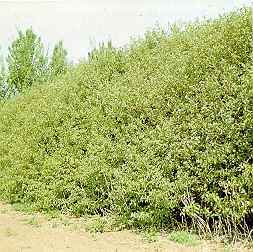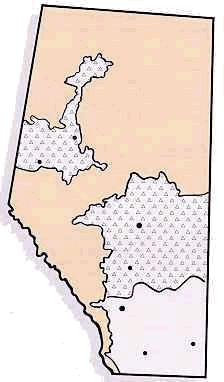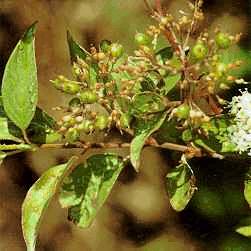| | Plant characteristics | Fall colour | Site preference | Hardiness | Uses | Disease and insects | Pruning
.

Scientific Name: Cornus sericea L.
Plant Characteristics
Deciduous, thicket forming shrub with arching branches which may easily take root, producing a multi-stem shrub.
Dogwood can reach a height of 2 to 3 m (6 to 10 ft) with a spread of 2 m (6 ft).
Dogwood can live a very long time. This shrub can be cut back to ground level after 10 to 12 years to rejuvenate it. Has a moderate to fast growth rate, from 10 to 45 cm (4 to 18 in.) a year.
Leaves - Leaves are opposite, simple, ovate to lanceolate, 6 to 12 cm (2.5 to 5 in.) long, smooth margins, prominent veins, rounded at base, with pointed tips, dark green above, underside paler with short hairs.
Flowers - Dull greenish white, several in a flat terminal cluster, 3 to 5 cm (1 to 2 in.) across, blooms May to June. If summer is moist may get a second flowering.
Fruit - White drupe, 4 to 5 mm (up to 0.25 in.) across from July to September.
Back - Stem colour various, mostly blood red, brightest in late winter. The young twigs make it easy to recognize, older bark turns greenish grey after four to five years.
Fall Colour
Red twigs offer winter colour.
Site Preference
Dogwood is found on a range of soil moisture conditions from well drained to poorly drained soils. It can withstand flooding during the growing season. It is also found in drier situations along forest margins and it often invades grasslands. Dogwood does best on free draining soils with adequate available moisture. Dogwood has low drought tolerance.
Prefers open sites, grows under light shade.
Is not salt tolerant and has a medium acid tolerance.
Hardiness
Hardy, but on occasion may suffer winter dieback.
.


Uses
Hedge material, specimens and background plantings. Dogwood will produce a thicket, which can be planted alongside of poplar for a field shelterbelt when planted 1 to 2 m (2 to 6 ft) between plants in the row. It has ornamental value, and it also provides food and cover for wildlife, including ruff grouse, shelter for mule deer and browse for moose and elk.
Disease and Insects
Some galls and leaf spots have been observed. No specific susceptibilities noted. Oyster shell scale can kill the plant.
Pruning
Dogwood can propagate itself by rootsuckers, stolons or seeds, creating a thick hedge, which can after time, become spindly. Spreading branches should be removed to keep it in bounds.
.
.
Shelterbelts Varieties for Alberta provides information on a number of other trees and shrubs than may be suitable for shelterbelts.
Visit our website directory for the Reforestation Woodlot Listings. |
|